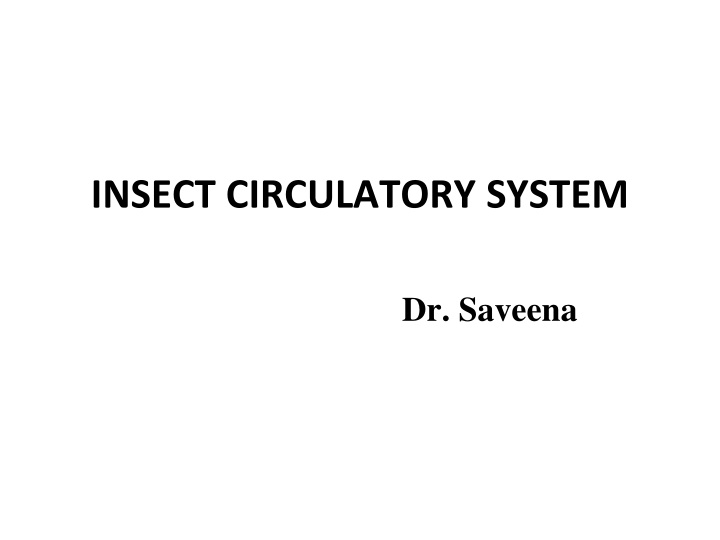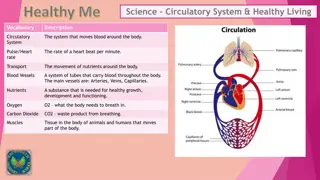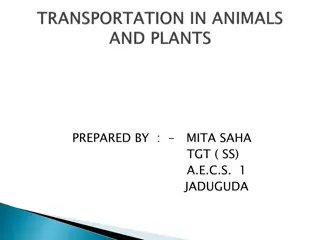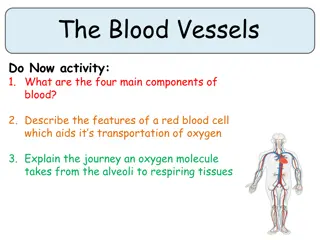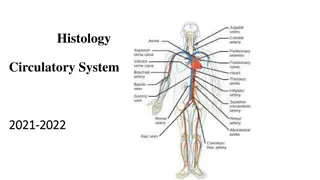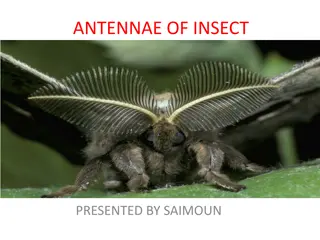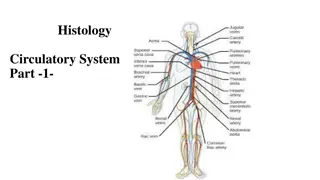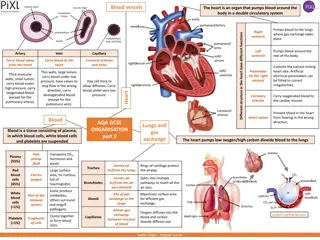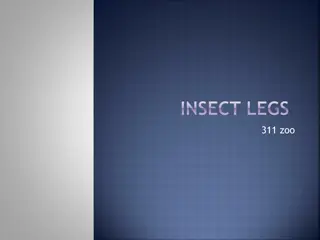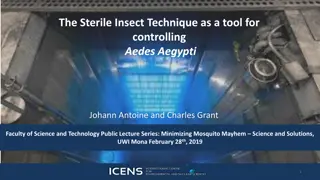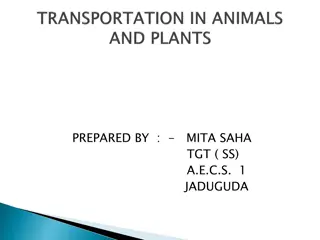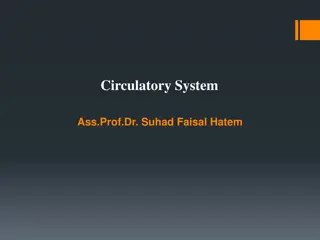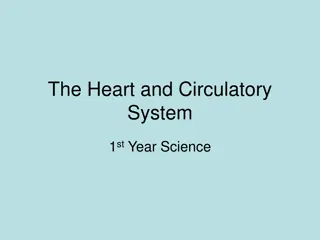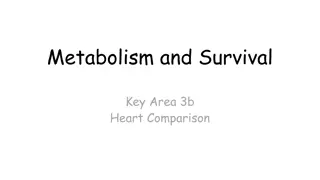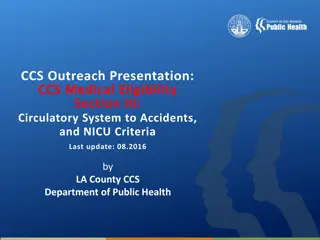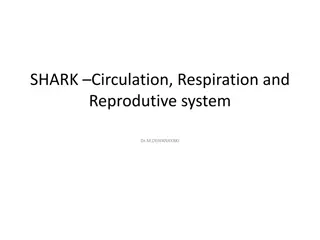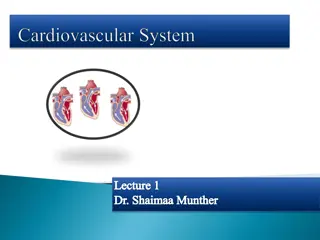Insect Circulatory System: Overview and Functions
The insect circulatory system comprises an open type, where blood flows through the body cavity. Divided into three sinuses, it houses vital organs such as the heart and nerve cord. The dorsal vessel acts as the main organ of circulation, along with accessory pulsatile organs that supply blood to appendages. Haemolymph composition includes plasma and haemocytes, with essential nutrients for insect survival. Understanding the unique features of the insect circulatory system sheds light on its biological processes.
Download Presentation

Please find below an Image/Link to download the presentation.
The content on the website is provided AS IS for your information and personal use only. It may not be sold, licensed, or shared on other websites without obtaining consent from the author.If you encounter any issues during the download, it is possible that the publisher has removed the file from their server.
You are allowed to download the files provided on this website for personal or commercial use, subject to the condition that they are used lawfully. All files are the property of their respective owners.
The content on the website is provided AS IS for your information and personal use only. It may not be sold, licensed, or shared on other websites without obtaining consent from the author.
E N D
Presentation Transcript
INSECT CIRCULATORY SYSTEM Dr. Saveena
Circulatory system There are two types of circulatory systems in the animal kingdom. In many animals , the blood travels through vessels like arteries, capillaries and veins. This is known as closed type of circulatory system. In insects the blood flows through the body cavity (i.e., heamocoel) irrigating various tissues and organs. It is known as open type of circulatory system.
Haemocoel of the insects is divided into 3 sinuses (or) regions due to the presence of two fibro muscular septa (or) diaphragms composed of connective tissues 1)Dorsal or Pericardial Sinus: The area lying in between the tergum and dorsal diaphragm . It contains heart. 2) Ventral or Perineural Sinus: The area lying in between the sternum and ventral diaphragm. It contains nerve cord. 3)Visceral Sinus: The area in between dorsal and ventral diaphragms . It harbour the visceral organs like alimentary canal and gonads.
Organs associated with blood circulation Dorsal bloodvessel It is the main organ of circulation and consists of anterior aorta and posterior heart. The dorsal vessel is a simple tube closed at its posterior end and bears a number of vulvular openings called as ostia ( prevents back flow of haemolymph) The number of ostia are 3 pairs thorax 9 pairs -abdomen
Accessory pulsatile organs: Insects consists of sac like structures called accessory pulsatile organs, which are present at the base of the appendages such as wings, legs and antenna. They pulsate independently and supply adequate blood to the appendages.
Composition of Haemolymph -contains a fluid portion called plasma and cellular fractions called haemocytes. 1.Plasma: Plasma is an aqueous solution of inorganic ions, lipids, sugars (mainly trehalose), amino acids, proteins, organic acids and other compounds. pH is usually acidic (6-7). Density is 1.01 to 1.06. Water content is 84-92 per cent. Inorganic ions present are `Na' in predators and parasites, `Mg' and `K in phytophagous insects. Blood lacks vitamin K Carbohydrate is in the form of trehalose sugar. Major proteins are lipoproteins, glycoproteins and enzymes. Lipids in form of fat particles or lipoproteins. Glycerol is present which acts as a anti freezing compound.
Haemocytes: The blood cells or haemocytes are of several types and all are nucleate. Different types of haemocytes are as follows: a.Prohaemocyte : Smallest of all cells with largest nucleus. b. Plasmatocyte (Phagocyte) aids in phagocytocis c. Granular heamocyte: Contains large number of cytoplasmic inclusions d. Spherule cell: Cytoplasmic inclusions obscure the nucleus
e.Cystocyte(Coagulocyte): Role in blood coagulation and plasma precipitation. f.Oenocytoids: Large cells with ecentricnucleus g. Adipo haemocytes: Round or avoid with distinct fatdroplets h.Podocyte: Large flattened cells with number of protoplasmic projections. i. Vermiform cells: Rare type, long threadlike.
Process of blood circulation: Heart mainly function as a pulsatile organ whose expansion and contraction leads to blood circulation. It takes place generally in an anti clock manner starting from posterior end to the anterior end in a forward direction. Circulation of blood takes place in two phases due to the action of the alary muscles as well as the muscles of the walls of theheart. The two phases are 1. Diastole: During which expansion of heart takesplace. 2. Systole : Contraction of heart takesplace.
1.Diastole: Expansion of heart ( diastole). It results in increase of volume of heart and decrease in the area of pericardial sinus. This creates a pressure on the blood in pericardial sinus forcing the blood to enter into the heart through the incurrent ostia. These incurrent ostia allow only the entry of blood from the sinus in to the heart and prevents its backflow from the heart to the sinus. 2.Systole : Contraction of heart (systole). This creates pressure on the blood within the heart leading to its forward movement in to the aorta. From the aorta blood enters in to the head and flows back bathing the visceral organs in the visceral sinus and neural cord in the perineural sinus. In between diastole and systole there will be a short period of rest which is known as diastasis.
Functions of haemolymph 1.Lubricant : Haemolymph keeps the internal cells moist and the movement of internal organs is also made easy. 2. Hydraulic medium : Hydrostatic pressure developed due to blood pumping is useful in the following processes. a) Ecdysis (moulting) b) Wing expansion in adults c) Ecolosion in diptera (adult emergence from the puparium using ptilinum) d) Eversion of penis in male insects e) Eversion of osmeteria in papilionid larvae f) Eversion of mask in naiad of dragonfly g) Maintenance of body shape in soft bodied caterpillars.
3.Transport and storage : Digested nutrients, hormones and gases (chironomid larva) were transported with the help of haemolymph. It also removes the waste materials to the excretory organs. Water and raw materials required for histogenesis is stored in haemolymph. 4.Protection: It helps in phagocytocis, encapsulation, detoxification, coagulation, and wound healing. Non celluar component like lysozymes also kill the invading bacteria. 5.Heat transfer: Haemolymph through its movement in the circulatory system regulate the body heat (Thermoregulation).
6.Maintenance of osmotic pressure: Ions, amino acids and organic acids present in the haemolymph helps in maintaining osmotic pressure required for normal physiological functions. 7.Reflex bleeding: Exudation of heamolymph through slit, pore etc. repels natural enemies. e.g. Aphids. 8.Metabolic medium: Haemolymph serves as a medium for on going metabolic reactions (trahalose is converted intoglucose).
